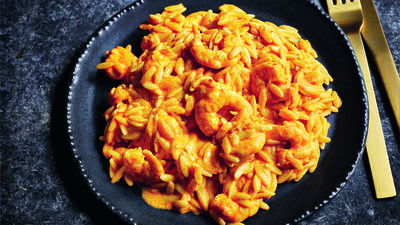This recipe was taken from Francis Lam's story on how to make and modify beurre blanc
Yield: Makes about a pint, which goes a long way (it will probably serve 8 to 12).
Note: Feel free to cut this in half, but much less than that becomes a little hard to control because you won't have much liquid to work with.
Ingredients
8 ounces dry white wine
3 tablespoons good-quality vinegar (white wine is traditional, but I like a nice aged sherry vinegar, even though it gives a brownish color)
1 medium shallot, finely chopped
1 pound (yes, you heard me right) unsalted butter, cold
Salt and pepper, to taste (white pepper is traditional, to keep with the color theme)
Lemon juice, to taste (optional)
Instructions
1. Put the wine, vinegar and shallot into a saucepan big enough for you to fit all the ingredients plus the head of a whisk. (Speaking of which, try to use a smaller whisk; one of those giant balloony ones might miss all the corners of the pot.) Set it over medium-high heat and let it bubble briskly, reducing it to a syrupy consistency (until it's about 2 tablespoons).
2. While the liquid is reducing, cut the butter into ½-inch pieces. If it's very cold, let it sit out—you want it a bit cooler than room temperature when you start whisking it in. But if it's softening or melting, get it back in the fridge or freezer pronto, s'il vous plait.
3. When the reduction is ready, remove the pan from the heat and turn the flame down to the lowest setting. Add 6 or so chunks of butter and whisk them in. It should look like it's dissolving into the sauce, making it look creamy, not melting and separating into a yellow, oily slick. If it's doing that, add in a bunch more butter and whisk away. What's happening is that it's too hot and the butter is melting more quickly than you're able to emulsify it into the reduction. Adding more cold butter will help to cool it down.
4. When the mixture is looking creamy and all the butter you've added is incorporated, put the pan back on low heat and continue to whisk in the rest, a couple of chunks at a time. (If you're really a star, you can ditch the whisk entirely and just swirl the pan as you add butter. It makes you a little cooler, but I'm not sure it makes the sauce any different.)
5. When all the butter is completely incorporated and the sauce looks smooth, season it to taste with salt and pepper and, if needed for perfect balance, a squeeze of lemon or maybe a little more butter. Feel free to strain out the shallots, but I never do.
Holding this sauce is a tiny bit tricky, since keeping it over a flame will break it, and letting it cool completely to room temperature will break it. Usually I'll just keep it on an unused burner on the stove, and the warm air around it as other burners are going will keep it just right. Give it a whisk once in a while to make sure it's still smooth.
Note: If your sauce does break because it's gotten too hot, all is not lost. Pour off the butter that looks oily, and whisk in a splash—say, a teaspoon—of cold water and some more cold butter pieces. It should look like it's coming back together, at which point you can try to reintroduce the poured-off molten butter. Do so carefully, and if it starts to look like the sauce isn't taking it, stop. Don't force it. It won't play well if you do.
If it's gotten too cold and solidified and broken that way, then try chilling it until cold in the fridge. Cut it into small chunks, and whisk it into heavy cream that you've reduced by half.
Before you go...
Each week, The Splendid Table brings you stories that expand your world view, inspire you to try something new, and show how food connects us all. We rely on your generous support. For as little as $5 a month, you can have a lasting impact on The Splendid Table. And, when you donate, you’ll join a community of like-minded individuals who love good food, good conversation, and kitchen companionship. Show your love for The Splendid Table with a gift today.
Thank you for your support.
Donate today for as little as $5.00 a month. Your gift only takes a few minutes and has a lasting impact on The Splendid Table and you'll be welcomed into The Splendid Table Co-op.



